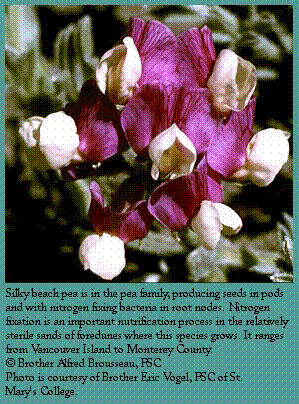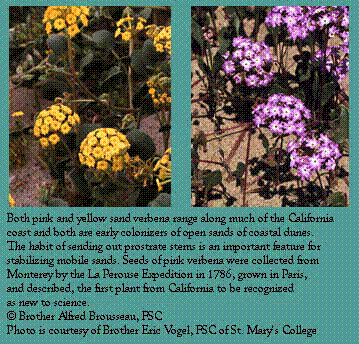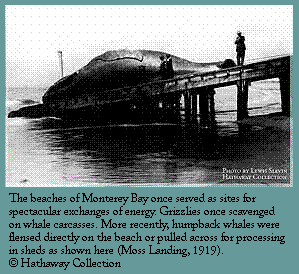Coastal Dunes
II. Coastal Dune Community
The active coastal dune community (code G3 S2.2; Sawyer and Keeler-Wolf 1995) is considered threatened, having a moderately limited distribution throughout its range, with a limited distribution in California (ibid).
A. Physical Features
The active coastal dunes (i.e. beach) plant community occupies sands between mean high tide and the furthest reach of storm waves, which extends to the top of the first, or fore-, dune. This community is extensive in the northern part of the MBNMS where there is a sufficient sand supply, particularly Monterey Bay and also along the many beaches in Santa Cruz and San Mateo Counties. It is very limited beneath the cliffs of the Big Sur coast (Figure 1).
The climate of this zone is maritime, characterized by high exposure to air-borne salts and sand blast, and shifting substrate of low water-holding capacity and organic matter (Breckon and Barbour 1974). Rain falls in winter, averaging just 46 cm annually. Summer fog tempers heat: mean air temperature in January is 50°F and only 60°F in July (Harville 1971). Monterey beaches are intermediate in climate (Bakker 1984) between northern California (e.g. Humboldt County) where rains dilute salinity and forest may grow right onto beaches, and southern California, where salt spray carries inland and the inland climate is desert or desert-like (Munz 1964).
B. Vegetation Patterns
Two ecofloristic zones which meet at Point Conception were recognized by Breckon and Barbour (1974) and Barbour et al (1975), with the north zone much more speciose than south. However, the latitudinal correlates between vegetation and rainfall, frost, insolation, and air and water temperatures are only approximate (Barbour and Johnson 1988); microenvironmental factors such as salt spray, sand movement, presence of non-native vegetation and protection from storm waves are the most significant local determinants of community extent (Barbour et al 1975).
 Physical instability of sand and water movement and the physiological stress
of the high salts exclude most species, though C4 species (with water-efficient
metabolism) such as beach salt bush do occur here (Barbour et al 1993). All foredune plant species may be found in back dunes as well, often in disturbed
areas. Barbour et al (1985) found that microenvironmental gradients back
from the tideline do not appear significant in determining growth form,
leaf form or metabolic traits.
Physical instability of sand and water movement and the physiological stress
of the high salts exclude most species, though C4 species (with water-efficient
metabolism) such as beach salt bush do occur here (Barbour et al 1993). All foredune plant species may be found in back dunes as well, often in disturbed
areas. Barbour et al (1985) found that microenvironmental gradients back
from the tideline do not appear significant in determining growth form,
leaf form or metabolic traits.
This beach community is characterized by open sands, cover of plants is usually less than 10% of the total area (Barbour and Johnson 1988). Beach plants are pioneer species which form hillocks above the high tide line by accumulating wind-blown sand and continually growing above burial. These hillocks may persist through one or more years. However, storm waves eventually destroy them, often during the violent, high-tide storms of winter when huge quantities of sand are removed from the beach.
As a permanently disturbed habitat, the beach community would seemingly foster a high proportion of plants with an opportunistic life cycle, i.e. annuals. However, all but the sea rockets are perennials, perhaps because of the difficulty in establishing seedlings (Breckon and Barbour 1974) due to lack of suitable microsites (Barbour 1970, 1972). All species are low-growing with trailing stems or rhizomes and succulent or broad leaves. Pitts (1976) describes the effects of grazers, vertebrates and invertebrates, and physical stress on many beach plant species to explain their relatively high reproductive effort and prostrate form.
In general, there are only five or so plant species which comprise the vegetation on any one beach and foredune face in the MBNMS, and usually only one or two are dominant (Barbour and Johnson 1988). The beach/foredune community at Salinas River State Beach is typical of this pattern (Bluestone 1981). Most often dominant are sea rocket, beach wild rye, beach bur and sea fig; yellow sand verbena, beach salt bush, silky beach pea and European dune grass (i.e. marram) are subdominants.
C. Selected native plant species
 Common native plants of the beach community include beach wild rye, beach bur, yellow sand verbena,
beach salt bush, and silky beach pea. Monterey Bay is the approximate southern
distributional boundary of beach wild rye (Beetle 1947) and silky beach
pea (Bakker 1984). The southern MBNMS boundary is near the southern boundary
of yellow verbena.
Common native plants of the beach community include beach wild rye, beach bur, yellow sand verbena,
beach salt bush, and silky beach pea. Monterey Bay is the approximate southern
distributional boundary of beach wild rye (Beetle 1947) and silky beach
pea (Bakker 1984). The southern MBNMS boundary is near the southern boundary
of yellow verbena.
Thorough reviews of native dune plant life histories are readily available in sources such as Barbour and Major (1988) and others (see IV. Selected coastal dune resources).Therefore, this chapter intentionally focuses more strongly on introduced species, which are less well studied and of great management concern.
D. Selected non-native plant species
The high proportion of non-native cover in the MBNMS beach community -especially by marram, sea rocket and sea fig - is striking. Note that introduced species are also successful on temperate Pacific beaches in South America and Canada. Ecology of these beaches may be analogous to that of islands: incidence of new arrivals may be too low to provide a closed community, so competitive interaction is minimal and introductions can fill open niches or aggressively outcompete natives (Breckon and Barbour 1974). Success of introduced plants on beaches provides dynamic and intriguing ecological problems only partly documented and not well understood.
1. Sea rocket
Sea rocket is actually comprised of two non-native species, Cakile edentula and C. maritima. C. edentula, a native of eastern North America, was introduced to the San Francisco Bay area around 1880, probably from ship ballast, and spread to San Diego within 30 years (Barbour and Rodman 1970). The European native C. maritima was first observed in Marin County in 1935 and has largely replaced the first species in the Monterey Bay region (Bluestone 1981), perhaps because it produces more seeds.
2. Sea fig and Hottentot fig
Sea fig is distinguished by its pink flowers from yellow-flowered Hottentot fig. Both iceplants are native to South Africa, although the origin and arrival of sea fig to North America has not been firmly established (Bicknell and Mackey 1988). Sea fig behaves more like a native and is less invasive than Hottentot fig, although both form clonal mats (Pickart 1988). Though both grow in the beach community, sea fig is much more abundant in the MBNMS.
3. Marram (European dune grass)
Marram was introduced for dune stabilization to San Francisco in 1869 (Lamb 1898) and the Pajaro dunes in 1919 (Gordon 1996). It has also recently been planted around the Monterey Dune Colony. It has become a dominant on north coast beaches (Bakker 1984), where it is reported to replace native dune grass and beach wild rye (Schoenherr 1992). It hosts nitrogen-fixing bacteria in the rhizosphere lending it a competitive advantage in characteristically nitrogen-poor sands (Pickart 1988). Marram aggressively outcompetes all other plants, creating large monospecific stands. In contrast, native dune grass is spaced in clumps which encourages more diverse plant assemblages (Bakker 1984). Within the past few decades, marram has invaded the dunes between the Pajaro River and Moss Landing to form a large, nearly monospecific stand. Another large stand grows along Point Franklin, near Año Nuevo.
Marram changes the shape of dunes. Its rhizomatous roots grow deep, immobilizing normal sand movement. High ridges are formed which are oriented at right angles to prevailing wind direction, whereas native vegetated dunes are lower and ridges run parallel to winds (Barbour et al 1993). The shape produced by marram causes a steeper foredune face which is unstable (Brown and McLachlan 1990). This shape also starves dunes by blocking sand; reduction in sand supply leads in turn to rapid degradation of dune fields. This process can be observed south of the Pajaro River where tall, steep foredunes are topped with dense marram stands. Winter storm waves in 1995 eroded foredunes into vertical walls greater than ten feet tall and carried the sand offshore: on native-vegetated dunes, the sand would have blown inland. Marram may be the worst weed in central California, destroying scarce habitat which is also threatened by development and overuse. No feasible control of marram has been developed.
E. Animals of the coastal dune community
 Few animals are obligate coastal dune dwellers. However, this very exposed
habitat probably once hosted an intriguing mix of visitors such as tule
elk (as at Prairie Creek in northern California), grizzlies (and more recently, humans) scavenging
whale carcasses (Gordon 1996Gordon 1996), and possibly sea otters taking refuge at
night from winter storm waves as in Alaska (pers. obs.). Elephant seals
mate, give birth and molt here (see Marine Mammal section). Western snowy
plovers (federally listed as threatened in 1993) are dependent on undisturbed
beach where they make scrape nests just above high tide line; abundance
in Monterey County has decreased significantly due to disturbance, especially
as a result of introduction of a non-native predator, the red fox (Roberson
and Tenney 1993, and see Seabirds and Shorebirds section). Black legless
lizards (a proposed federal candidate 2; Beattie 1995) and silvery legless
lizards (state species of special concern) live primarily under less disturbed
sands (Bury 1981) but have been observed to move into this beach community
at Moss Landing (Creative Environmental Conservation 1995). The globose
dune beetle (federal candidate 2) is fossorial and restricted to foredunes
within 100 feet of the wave wash zone. It has not been collected from Monterey
beaches for many years, and may have been extirpated here (Doyen 1976).
Few animals are obligate coastal dune dwellers. However, this very exposed
habitat probably once hosted an intriguing mix of visitors such as tule
elk (as at Prairie Creek in northern California), grizzlies (and more recently, humans) scavenging
whale carcasses (Gordon 1996Gordon 1996), and possibly sea otters taking refuge at
night from winter storm waves as in Alaska (pers. obs.). Elephant seals
mate, give birth and molt here (see Marine Mammal section). Western snowy
plovers (federally listed as threatened in 1993) are dependent on undisturbed
beach where they make scrape nests just above high tide line; abundance
in Monterey County has decreased significantly due to disturbance, especially
as a result of introduction of a non-native predator, the red fox (Roberson
and Tenney 1993, and see Seabirds and Shorebirds section). Black legless
lizards (a proposed federal candidate 2; Beattie 1995) and silvery legless
lizards (state species of special concern) live primarily under less disturbed
sands (Bury 1981) but have been observed to move into this beach community
at Moss Landing (Creative Environmental Conservation 1995). The globose
dune beetle (federal candidate 2) is fossorial and restricted to foredunes
within 100 feet of the wave wash zone. It has not been collected from Monterey
beaches for many years, and may have been extirpated here (Doyen 1976).
F. Community transitions
1. Seaward
(and see Sandy Beaches section)
High intertidal sands occur seaward of the beach community, representing a major transition zone. Below are mid- to low-intertidal sands, i.e. strictly marine habitat occupied only by aquatic invertebrates. No vascular plants grow on high intertidal sands. Terrestrial animals are at most transitory, e.g. barn swallows hunting kelp flies.
2. To marshes, streams and rivers
(and see River Mouths, Brackish & Estuarine Wetlands section)
Salt marsh vegetation at the Salinas River mouth and lagoon interfaces with dune and beach vegetation. The salt marsh amphipod hopper (Traskorchestia traskiana) lives in pickleweed, alkali heath, salt grass and fleshy jaumea (the four primary salt marsh plants) and may also associate with beach plants at interfaces of the two habitats (Gammel 1973). Coastal salt marsh remnants may be observed in small patches along creek mouths. Only remnants remain at the San Lorenzo, Pajaro and Salinas River mouths, due to development, river channelization, and agriculture.
Cooper (1967) described rear dune swales vegetated by alders, willows, rushes at water table level. Along Monterey Bay, these habitats provided the last, most downstream, freshwater recharge to aquifers which are now severely intruded by salt water. They are now farmed, e.g. along the Old Salinas River Channel and south of the Pajaro River; or dried out, e.g. northwest of Marina.
Numerous creeks and rivers breach the beach in and north of Monterey Bay and often form coastal lagoons (Redwood, Pilarcitos, Purisima, Lobitos, Tunitas, San Gregorio, Pomponio, Pescadero, Gazos, Whitehouse, Cascade, Año Nuevo, Waddell, Scott, San Vicente, Majors, Baldwin, Wilder, San Lorenzo, Arana Gulch, Rodeo Gulch, Soquel, Aptos, Pajaro and Salinas River). These waterways conduct anadromous, marine and brackish water fish through seasonally changing waters, and/or the lagoons provide habitat for adults or young of numerous fish species, e.g. salmon, steelhead, lamprey, sculpins, eulachon, herring, tidewater goby, stickleback, killifish, starry flounder and surfperch (Kukowski 1972; and see Anadromous Fishes section). Roberson and Tenney (1993) describe present and known historical bird use of the Salinas River mouth area (displaced 5 miles south from the historical opening). Other habitats such as now-rare northern foredune grasslands (see II.F.3. below) probably intersected here and supported animals as large as tule elk. Large predators such as grizzlies and native Americans were especially attracted to such rich beach interfaces (Gordon 1996). These present-day and historical summaries convincingly convey a sense of the historic diversity and biological wealth at these beach interfaces.
3. Inland: foredune, central dune scrub and foredune grassland
The active coastal dune community continues landward on loose sands as the northern foredune community followed by the central dune scrub community (Holland 1988). Sawyer and Keeler-Wolf (1995) described northern foredunes (code G2 S2.1) as of limited distribution throughout California, and very threatened. Central dune scrub (G2 S2.2) was rated as limited in distribution throughout its range, and threatened (California Department of Fish and Game 1994).
The foredune and central dune scrub communities are well developed where dune systems are developed (Figure 1). Bluestone (1981) described 7 zones at Salinas River State Beach from the beach to these two loose-sand communities. Changes included greater plant density, more cover, more species and woodier species, i.e. from dominants of silky beach pea, beach sage wort, beach morning glory and sand verbena in the foredunes to live-forever, mock heather, blue beach lupine and lizard tail in the central dune scrub. Endangered disturbance-ecology species, including Monterey spineflower and sand gilia (Dorrell-Canepa 1994) live on open sand of the coastal foredune. Note that disturbances in the foredune, e.g. blowouts, may also be colonized by beach community species, such as beach sage wort.
McBride and Stone (1976) claimed that sands on Monterey Peninsula dunes succeed to brushland, pine forest then oak forest climax as the soils become moister and more organic. However, it is not clear if time or distance from the sea is most critical to the formation of a climax community (Barbour and Johnson 1988).
Historically, a northern foredune grassland (Holland 1986) was widespread from Monterey Bay to Coos Bay. This sparse grassland of beach wild rye and dune bluegrass still grows in a few isolated occurrences north of San Francisco, e.g. the mouth of the Mattole River in Humboldt County. It is very threatened through all its range and very rare (G1 S1.1; Sawyer and Keeler-Wolf 1995); it no longer occurs in the Monterey Bay area.
G. Coastal closed-cone forest and coastal scrub
Two other significant terrestrial plant communities grow along the edge of the MBNMS: coastal closed-cone forest and coastal scrub. Both are subject to the coastal climate, wind and some degree of salt spray. However they grow mostly in stable terrestrial soils on bluffs, cliffs or hillsides well above sea level.
Closed-cone forest species have contributed to the fame of the MBNMS coastline. Four of California's eight coastal closed-cone forest communities grow within the MBNMS, all on the Monterey and Point Lobos Peninsulas. Two of them are unique to these locations: Monterey and Gowen cypress forests. The largest Monterey Pine forest also grows along the Monterey Peninsula (Cylinder 1995). All three community types are very rare and very threatened (G1 S1.1; Holland 1986, Sawyer and Keeler-Wolf 1995). The fourth forest is the rare and threatened (G2 S2.2) northern Bishop pine community. Note that the many Monterey cypress trees and groves observed along the coast are not natural but have been planted.
Three coastal scrub communities are found on MBNMS shores: northern coastal bluff scrub, northern coastal scrub and central coastal scrub. All are characterized by medium to low shrubs on exposed slopes of poor soil. Northern coastal bluff scrub is of low to prostrate shrubs, exposed to constant winds and salt spray, typically on very steep ocean cliffs. Live-forever and lizard tail are characteristic plants. The community is rare and threatened (G2 S2.2). Northern coastal scrub grows along San Mateo and Santa Cruz counties, characterized by bush monkey flower, lizard tail, coyote bush and California sagebrush. It is also rare and threatened (G2 S2.2). Central coastal scrub, or coastal sage scrub (DeSimone 1995) is the equivalent along the Big Sur coast and California sagebrush, coyote bush, black sage are typical. These communities are typical of steep hill slopes above rocky coastlines with few or no beaches and therefore do not often interface with beach or dune communities. However, they may often be the nearest vascular plant community to the marine waters. The Pebble Beach Company is attempting to establish a scrub community on appropriate soil adjacent to the dune community at Spanish Bay, Asilomar Beach.
| < Previous - Section I. Climatic and Geologic Setting of Coastal Dune Communities |
||
